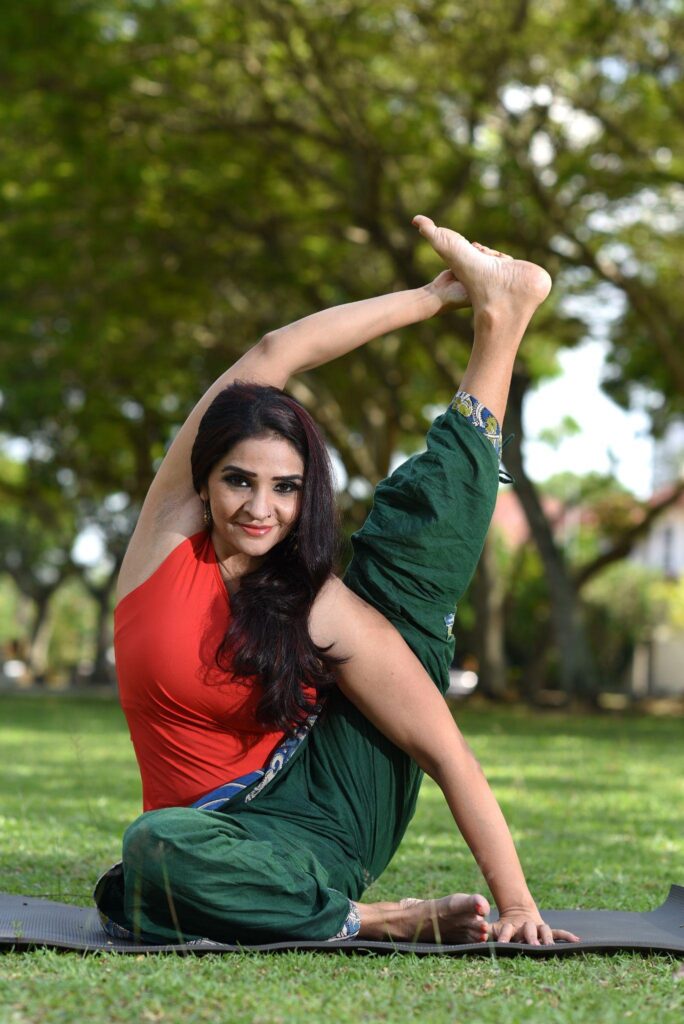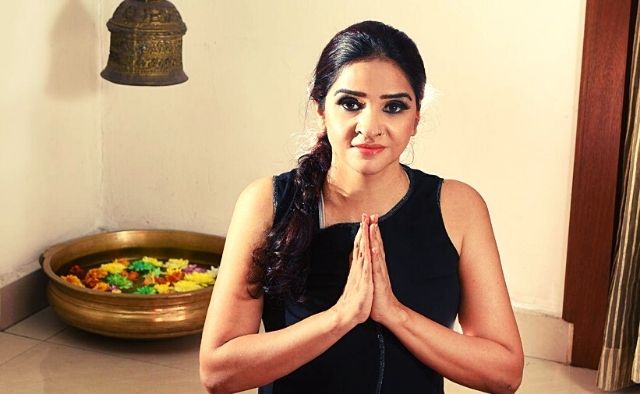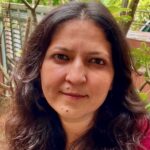Malaysia-based yoga teacher, author and speaker, Shailaja Menon, explains why yoga is an effective solution for mental health and stress — it’s a practice to educate the mind.
Yatra Manah? Where is your mind? How is your mind feeling? I found myself asking myself this question after talking to yoga teacher, author and speaker, Shailaja Menon. Her approach to yoga is all about ‘mindbody’ connection. “Our thoughts manifest our reality,” says Shailaja and she encourages her students to be aware of more than just the physical aspect of asanas when they practise. How is this done? Read on to find out:
Sophia: How did your yoga journey begin?
Shailaja: Yoga wasn’t a part of my vocabulary as a child. My family didn’t come from any yoga lineage and I had no exposure to yoga growing up. But, I felt a calling towards yoga early on. I used to have headaches in college and my father was a doctor — he told me the headaches are stress-related and I have to find a way to deal with the stress (laughs). So yes, needing to find a way to deal with stress was my entry point into yoga. I attended a meditation course at Integral Yoga (By Swami Satchidananda). At the time, that was all I did. I got married and moved to Malaysia, where my son was born. When he was around four-months-old, I went back to Coimbatore. I felt my mind was still not in a good place and something inside of me insisted that there was a better way to live. So I went back to Integral Yoga and tried a yoga class with asana , pranayama and yoga nidra. It was like a light was switched on. At the end of practise, I felt so Zen and calm. I remember thinking, ‘I never want this to stop.’ As destiny would have it, that is also where I met Swami Divyananda or Mataji, as I call her. She was managing the centre in Coimbatore at that point and became a big influence in my yoga journey. She was always filled with warmth, love and smiles. That’s one of the reasons yoga has alway been more than exercise to me. I was aware from the beginning that it had the capacity to transform and refine every aspect of the individual’s personality. Mataji directed me towards Swami Satchidananda’s teachings through his book, Beyond Words. My perspective on life until then was very limited — it was all about me. But this book changed that. It’s very simple reading and had two core messages that struck home. One was that you have to take responsibility for how you feel. It’s not about blaming other people, or thinking that the world is wrong. For example, you need to think about what causes your irritation or stress or anxiety. Once you identify that, you can create change from within yourself by changing your perspective of the situation. That book made me turn inward, look at myself and take responsibility for the state of my mind and my life. The second message I received from the book is that life is about giving. When you look at life in terms of giving, then all problems disappear. It was Mataji who encouraged me to do a teacher training programme as well and when she asked me to do it, it just felt like the most natural thing to do. That’s the story of my journey to yoga and how I started teaching. When I came back to Malaysia, I met another major influence on my practice — Manoj Kaimal, Manasa Yoga — and his approach is all about the mind. I truly believe that we are led to what we need. As I needed to learn to manage my own mind, I found teachers who cemented my journey in that direction.
Sophia: Which teachers/gurus influence your study and practise of yoga?
Shailja: It began with Mataji and Integral Yoga and I am influenced by the teachings of Swami Satchidananda. My teacher in Malaysia, Manoj Kaimal, shaped my teaching. I have been his student for the past 15 years. He layers the yoga sutras and other philosophies including Bhagavad Gita into asana practice and that makes ‘asana’ such a rich, meaningful experience. It is this vital context of philosophy that distinguishes asana from exercise. Recently, during the pandemic, I was exposed to Dr Ananda Balayogi Bhavnani (Yogacharya Dr Ananda Balayogi Bhavanani is Director of the Centre for Yoga Therapy Education and Research (CYTER), and Professor of Yoga Therapy at the Sri Balaji Vidyapeeth, Pondicherry). He has also inspired me in my understanding of yoga and its practice tremendously.

Sophia: You’re passionate about writing. Tell us about why you like to write and does it work for you as a form of Sadhana?
Shailaja: I cannot not write! My first book (Yoga Shakti) was published in 2018, and by the end of 2019, I was done with my second book. But, that was put on hold because of COVID, but I just finished reworking the book and I hope it is out by next year. I even have my third and fourth book written in my head (laughs). It’s just a matter of downloading them from my head to my laptop. Writing just flows from my heart. It is a beautiful sadhana and my bliss. My mind shifts into an elevated dimension as the words begin to flow.
Sophia: Tell us about your book, Yoga Shakti? What inspired you to write this book?
Shailaja: I’ve been a freelance writer for 20 years. I was writing on health and lifestyle...I also wrote columns for magazines and it wasn’t satisfying because it was mostly asana-centric. Editors would instruct me exactly what they wanted me to write about. My approach has always been mind-based, one that includes philosophy and meditation. These are the practices that open our mind and give us a broader perspective. So at one point, I just started writing what I wanted to share (laughs). I pour all my knowledge and learning over these twenty years into these books and I am so happy to have an opportunity to share that. Through my writings, I also want to shine the light and raise awareness of our mind. We have the capacity to shift the state of our minds and these practises help us move from unconscious to conscious living. Adi Shankaracharya explains; “whatever can be identified as ‘my or mine’ is not I”. So we are not our body and mind. This is such an important concept, as so most of us identify so strongly with the mind. We may not realize it but we are enslaved by our minds. Exposure to yoga philosophy and practice helps us manage and build a working relationship with it. Through our yoga practice; attention on body, breath, gazing points, we strengthen our capacity to choose our point of focus, hold attention, and eventually this can be applied in our everyday lives when we find our minds spiralling downward in anxiety or panic. Thus, this capacity that we develop in yoga class can be practiced in our everyday lives.
Sophia: On your website, you say that yoga is not just about stretching the body. Can you elaborate on that?
Shailaja: It begins with the body. Swami Satchidananda said that asana is like a calling card. A lot of people start with asana. In fact, this journey is about going from the gross to the subtle. The body is the gross aspect and it is easy to connect with. We can be aware of our body through movement. But have you tried feeling your mind or your subtle body? So asana is important, yes, in more than one way. According to Manoj Kaimal, one of the definitions of asana is “asyate iti asana”, that which can be seated upon. So what is seated upon it? It is a universal energy, shakti. So asana is not just a shape we make with our body. It is a grid through which this universal energy can be experienced. Thus when we practise asana, we should see it as an opportunity to connect with this shakti. This profound understanding of asana is what turns it into a spiritual practice. We also connect to the different dimensions of ourselves through the expanded lens of the pancha koshas; the layer of the body, anna maya, the layer of the energy, prana maya, the layer of the mind, mano maya, the layer of the intellect, vijnana maya as well as the layer of bliss, ananda maya .
Asana practice also creates the space in our life to witness our mind and use our intellect to make discerning choices. So asana is so much more than exercise. In today’s world, we are all so busy, so I encourage my students to use their time on the mat to connect with themselves, look at their patterns, the dysfunctions of their mind and make changes that are needed. To make it a “buddhi yukta” practice, yoked to the intellect, as opposed to being an ”ego-based” practice that only leads to dissatisfaction, comparison and injury. Thus the practice can be used to soothe and educate our mind along the lines of santosha contentment, ishvara pranidhana surrender to the universe, kritagyata gratitude, for us to evolve and grow as human beings. My motto is “Mat practice is Life practice”. So with awareness, we educate the mind on the mat so that it can reflect it in our everyday lives.
Sophia: You have given various talks on yoga and mental health and you also address issues like stress and how to use yoga to combat these lifestyle illnesses. Can you elaborate on that?
Shailaja: When people talk about health, there is so much focus on eating organic food, or exercising but nobody talks about mental health. I feel the mind has been so overlooked in the conversation on health. Now, It is widely acknowledged worldwide that chronic stress is such a major factor for disease and death. When I say mental health, people start thinking I am referring to conditions like Schizophrenia or Alziehmers... But I am talking about our daily mental health that affects a vast majority of our population. Stress and anxiety are life-threatening, too. I know so many people struggling with depression, loneliness, panic attacks - these are mental issues. Just waking up in the morning and feeling good can be a struggle. All of these issues can be dealt with effectively with a yoga practice that is done with awareness and intention. The most important thing is awareness of mind-body-breath-energy connection. All of these dimensions are connected. Our body feels what our mind feels - when we are anxious or stressed, our body tenses up, toxic chemicals or stress hormones like cortisol are released into our bloodstream affecting every cell in our bodies. Over a period of time it weakens our immune system and increases inflammation leading to autoimmune as well as cardiovascular and neurodegenerative diseases. So we can see how the state of our mind manifests physically. And this is not a newly discovered phenomena. Even in the Yoga Vasistha, one of the great classical Yoga Texts, in a dialogue between Sage Vasistha and Prince Rama, the concept of “adhija vyadhi”, psychosomatic ailments that manifest from an imbalance in the psyche is mentioned. Thus Yoga practice, with asana postures, pranayama working with energy through the breath, yoga nidra deep-relaxation as well as philosophy is a very holistic practice that brings about autonomic balance and facilitates healing and rejuvenation at a deep level. Deep breathing, especially long exhalations, activates the parasympathetic nervous system, bringing about the relaxation response thus giving us the capacity to offset stress. The tools of yoga philosophy, especially “pratipaksha bhavana”, given in the yoga sutras encourages us to cultivate the opposite perspective when we are faced with a negative pattern of thinking. I don’t know of any other practice that has the tools to positively affect every dimension of our existence; mind-body-breath-energy.
Sophia: What does yoga mean to you and how do you apply it in your daily life?
Shailaja: Yoga is a moment-to-moment application. It can be applied to everything. For example, if someone cuts you in traffic, the natural instinct is to curse and be angry. But then consider the other perspective that the person who cut you might be having an emergency or in a hurry to get somewhere. We don’t know the reason why people do things and yoga gives us the awareness to broaden and expand our mind and consider more than just our perspective. This attitude helps in every aspect of life, especially relationships, as we consciously make allowances for other people and are not so judgemental. So to use yoga in daily life is a constant choice. It is a constant application of svadhyaya, self-study and education of the mind on how to think and live in line with the yamas and niyamas of the Yoga Sutras. It also works on an energy level and gives us the tools to consciously lift our energy when needed.
Sophia: What do you miss most about India?
Shailaja: Everything. I try to come back as often as possible. I love the bonding. There is something so special about the heart-to-heart connections that people share and that is hard to find anywhere else. I love Rishikesh. I’ve only been there once but I keep feeling a call to go back.
Sophia: What are some of your favorite books on yoga and spirituality?
Shailaja: Books are my teachers. Beyond Words by Swami Satchidananda and he’s written a book on Sutras as well, that I love. There’s also Understanding the Yoga Darshan by Dr Ananda Balayogi Bhavanani and The Heart of Yoga by TKV Desikachar. I love BKS Iyengar’s Light on Life, too. And Manoj Kaimal’s book, “Making Patanjali Palatable”.
For more information on Shailaja and her upcoming books, visit Mat & Beyond.





